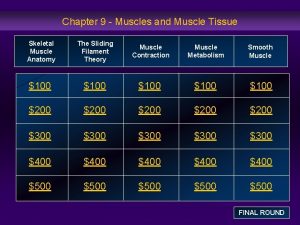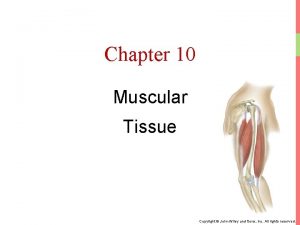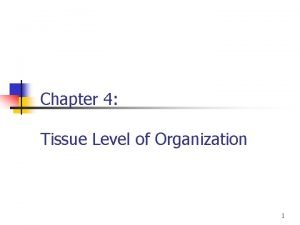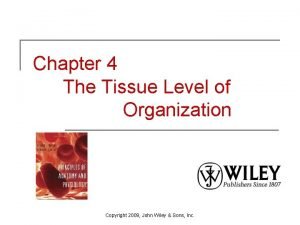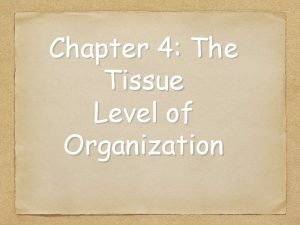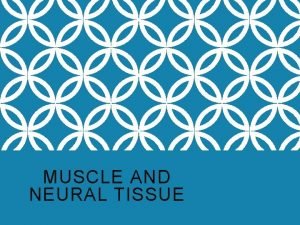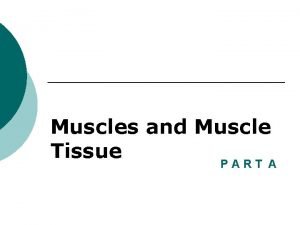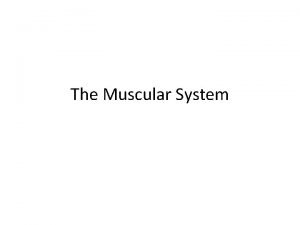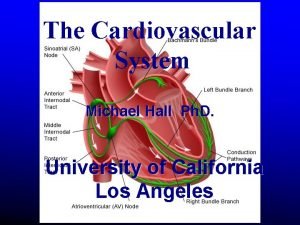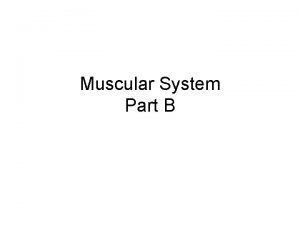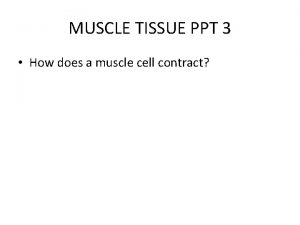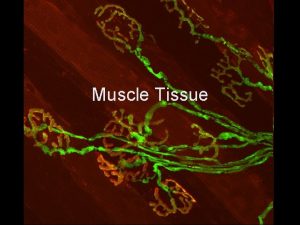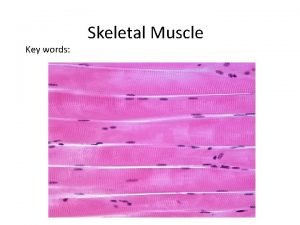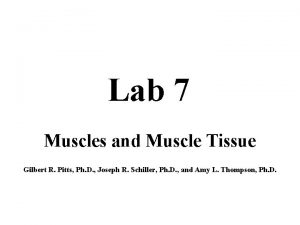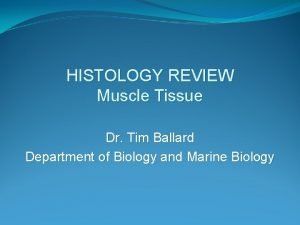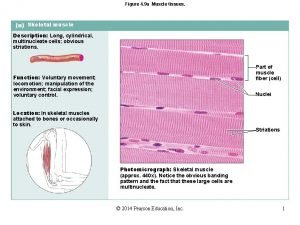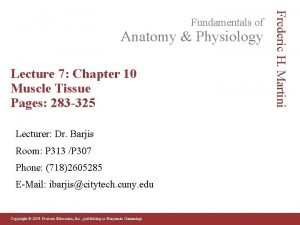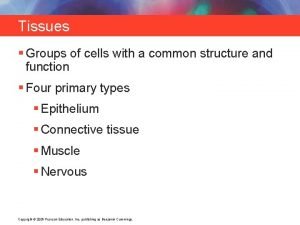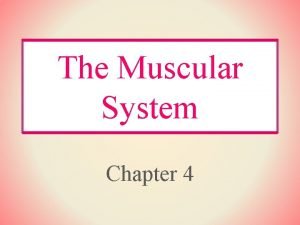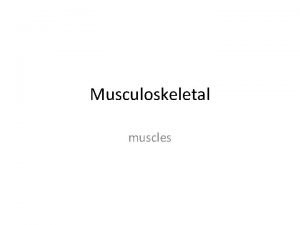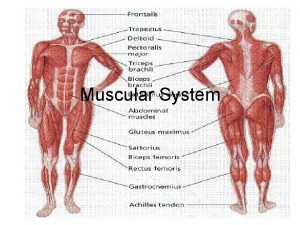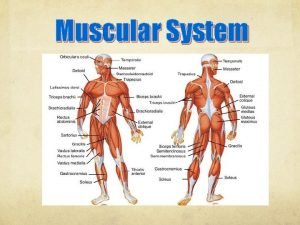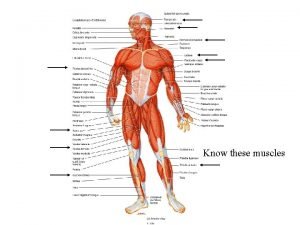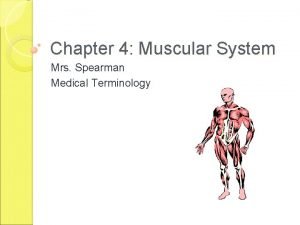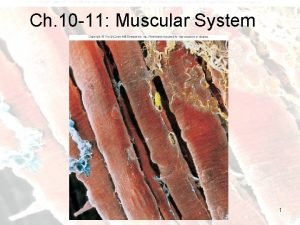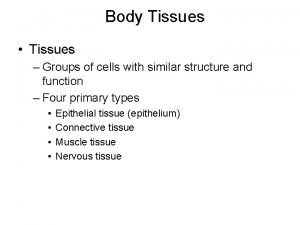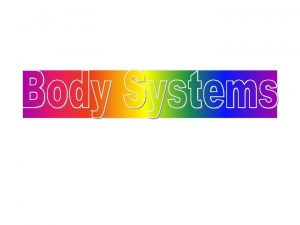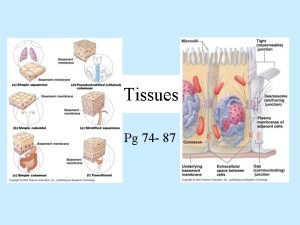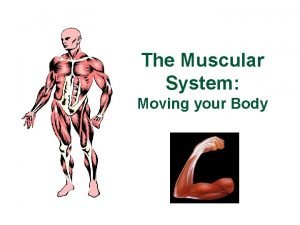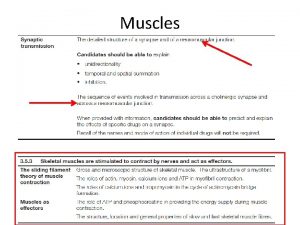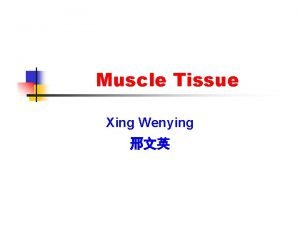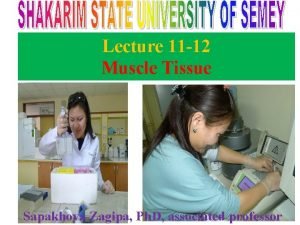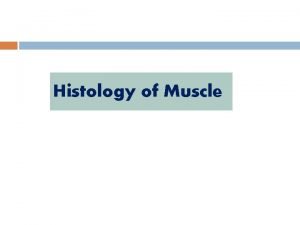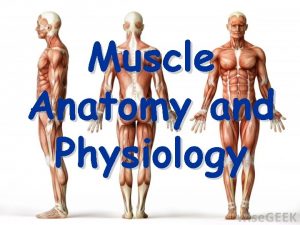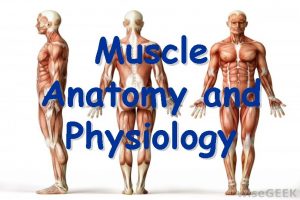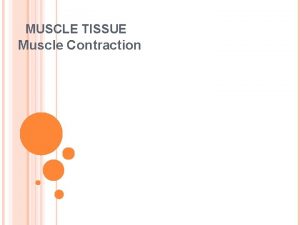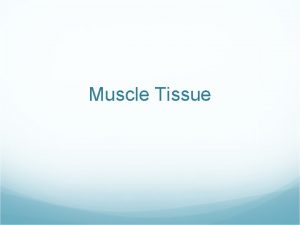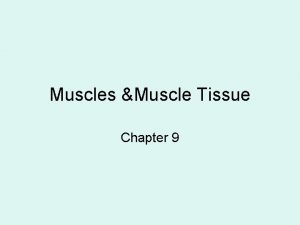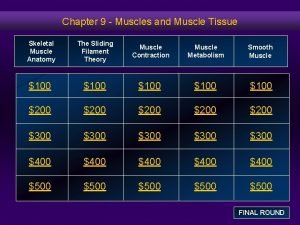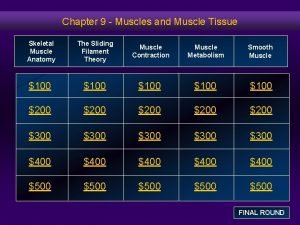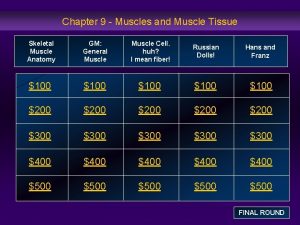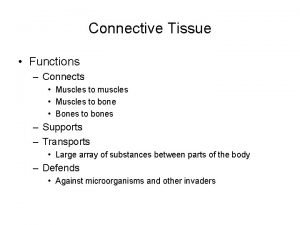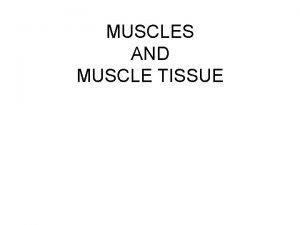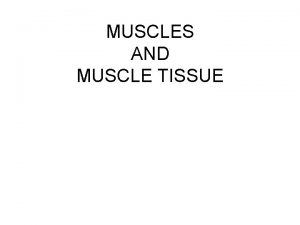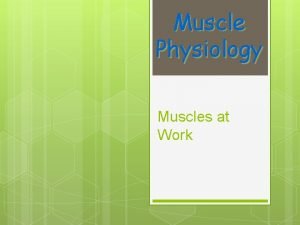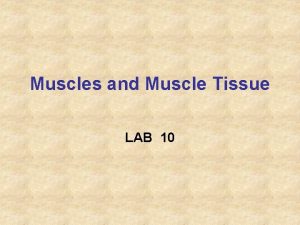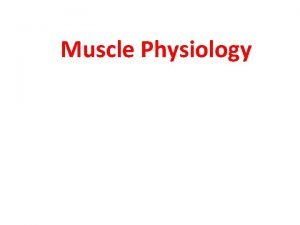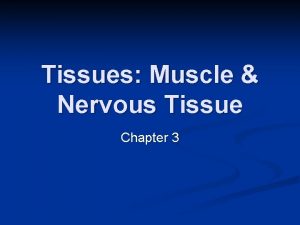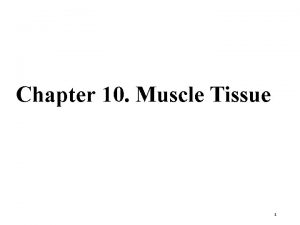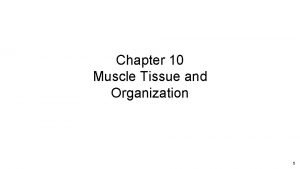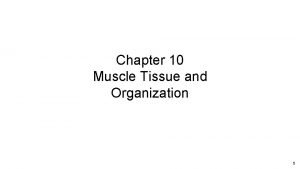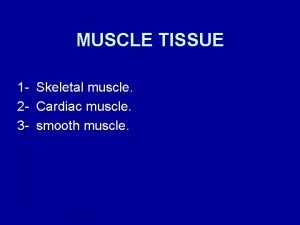Chapter 10 Muscle Tissue and Organization 1 Muscles




































- Slides: 36

Chapter 10 Muscle Tissue and Organization 1

Muscles • Skeletal muscles are voluntary muscles because they can be moved voluntarily • Heart and digestive muscles contract on their own

Muscles • Functions: – – Body movement Maintenance of posture Temperature regulation (especially shivering when you are cold) Storage and movement of materials • control of openings (sphincters) to gastrointestinal and urinary tracts – Support • abdominal cavity • floor of pelvic cavity

Table 10. 1 a • Muscles made up of fascicles – groups of muscle cells Muscle Fascicle Copyright © Mc. Graw-Hill Education. Permission required for reproduction or display.

Table 10. 1 a • Muscle cells are called muscle fibers • Muscle fibers contain protein strands called myofibrils Muscle Myofibril Muscle fiber Fascicle Copyright © Mc. Graw-Hill Education. Permission required for reproduction or display.

Table 10. 1 a • Myofibrils made up of proteins called myofilaments Thin filament Thick filament Actin molecules Heads of myosin molecules Myofibril Muscle fiber Fascicle Copyright © Mc. Graw-Hill Education. Permission required for reproduction or display.

Fig. 10. 1 Tendon Deep fascia Skeletal muscle • Tendons attach muscles to bones • Deep fascia covers muscle – dense irregular connective tissue – separates individual muscles – binds muscles with similar function – helps distribute nerves and blood vessels – fills spaces between muscles – sits deep to superficial fascia (aka subcutaneous layer)

Fig. 10. 1 Tendon Deep fascia Skeletal muscle (a) Muscle • Epimysium surrounds whole muscle (deep to deep fascia) Epimysium

Fig. 10. 1 • Perimysium surrounds each fascicle Tendon Deep fascia Skeletal muscle – dense irregular connective tissue – contains neurovascular bundles Epimysium Perimysium Nuclei Muscle fiber Fascicle Vein Nerve. Artery (a) Muscle (b) Fascicle

Fig. 10. 1 • Endomysium surrounds each muscle fiber – areolar connective tissue – insulates each fiber from electrical charge of other fibers (each can contract individually) – contains reticular fibers that bind neighboring muscle fibers together Fascicle Muscle fiber Endomysium (a) Muscle Copyright © Mc. Graw-Hill Education. Permission required for reproduction or display.

Endomysium Table 10. 1 c Myofibril Sarcoplasm Sarcolemma (plasma membrane) Satellite cell Muscle fiber Striations Nuclei (c) Muscle fiber

Fig. 10. 4 • Muscle fibers derive from myoblasts in embryo • Multiple myoblasts fuse Myoblasts into single cell with Myoblasts fuse multiple nuclei Satellite cell to form a skeletal • Satellite cells are muscle fiber myoblasts that didn’t fuse – assist in repair if muscle injured Satellite cell Muscle fiber

Fig. 10. 3 • Plasma membrane of muscle cell = sarcolemma (sarco = flesh) • Cytoplasm = sarcoplasm • Sarcoplasmic reticulum stores calcium ions needed for muscle contraction – Parts of SR extend deeper across cell, called transverse tubules Sarcolemma Sarcoplasm Mitochondria Myofibrils Myofilaments Transverse (T) Sarcoplasmic reticulum tubule Terminal cisternae Nucleus

Table 10. 1 d • Muscles move when myofilaments “walk” past each other • Myofibril shortens, contracting muscles • Muscles don’t “push”; They always pull Sarcomere Myofibril Myofilaments Thin filament Thick filament Actin molecules Heads of myosin molecules

Fig. 10. 6 Copyright © Mc. Graw-Hill Education. Permission required for reproduction or display. Muscle fiber Sarcomeres I band A band Z disc H zone I band Myofibril Z disc Myofilaments M line Sarcomere Transverse sectional plane (a) Sarcomere Z disc Thick filament Z disc Thin filament Connectin M line Thick filaments and accessory proteins H zone I band A band H zone I band Thick filaments Thin filaments Connectin I band (c) Z disc Thin filaments Connectin and accessory proteins (b) • Sections of fibers create striations (stripes) in muscle tissue Sarcomere TEM 400 x Z disc M line Z disc H zone I band A band I band (d) d: © James Dennis/Phototake

Fig. 10. 7 Copyright © Mc. Graw-Hill Education. Permission required for reproduction or display. Thin filament M line Connectin Z disc H zone Thick filament Z disc I band M line Z disc I band A band I band Sarcomere M line I band A band Sarcomere A band I band Sarcomere (a) Relaxed muscle Sarcomere, I band, and H zone at a relaxed length. M line Z disc I band H zone A band H zone Z disc M line Z disc I band A band M line A band I band Sarcomere Z disc H zone I band Sarcomere (b) Partially contracted muscle Thick and thin filaments start to slide past one another. The sarcomere, I band, and H zone are narrower and shorter. M line Z disc M line A band Z disc M line A band Sarcomere (c) Fully contracted muscle The H zone and I band disappear, and the sarcomere is at its shortest length. Remember the lengths of the thick and thin filaments do not change. a-c: © Dr. H. E. Huxley Sarcomere A band

Fig. 10. 8 Neuromuscular junction Axon of a motor neuron Synaptic knob Skeletal muscle fiber LM 500 x Path of nerve impulse Synaptic knob Endomysium Sarcolemma Synaptic cleft Acetylcholine (ACh) ACh receptor Acetylcholinesterase (ACh. E) Synaptic knob Motor end plate Synaptic vesicles Sarcolemma Sarcoplasm a: © Jean Claude Revy/ISM/Phototake

Fig. 10 Spinal cord Motor neuron 1 • Motor unit is a motor Motor neuron 2 neuron and all the muscle Muscle fibers innervated fibers it controls • One motor unit controls Neuromuscular by motor neuron 1 junctions some fibers in a muscle • Smaller motor units provide finer control (ex. eye muscles) • all-or-none principle means fibers contract completely or not at all – Force exerted depends on number of motor units activated

Fig. 10. 11 Isometric contraction Muscle tension < resistance Isotonic contraction Muscle tension > = resistance Movement No movement (a) Muscle tension less than resistance. Muscle does not shorten; No movement occurs. (b) Muscle tension equals or is greater than resistance. Muscle shortens; movement occurs.

Fig. 10. 12 • Muscle fiber types • Slow oxidative (type I) – slower, less powerful contractions – can contract for longer periods of time • Fast oxidative (type IIa) – least numerous – produce fast, powerful contractions • Fast glycolytic (type IIb) FO SO FG FG FO FG SO LM x 40 – most prevalent – provide power and speed – contract for short bursts only FO SO FO FO SO FG © Gladden Willis/Visuals Unlimited Copyright © Mc. Graw-Hill Education. Permission required for reproduction or display.

Fig. 10. 12 • Some muscles (ex. eye and hand) have no SO fibers • Number of SO and FG fibers in muscles does not change – people with lots of fast-glycolytic will always have lots of fast-glycolytic • Proportion of FO fibers change with physical conditioning FO SO FG FG FO FG SO LM x 40 – athletes can develop greater strength and endurance by transforming FO fibers into fibers more like SO or FG FO SO FO FO SO FG © Gladden Willis/Visuals Unlimited Copyright © Mc. Graw-Hill Education. Permission required for reproduction or display.

Fig. 10. 2 Muscle attachment Origin • At end of muscle, Relaxed connective tissue muscle layers merge to form tendon Tendon Contracted muscle – attaches muscle to bone, skin, or another muscle • thin, flattened sheet of tendon is called aponeurosis Movement of insertion of muscle Insertion Copyright © Mc. Graw-Hill Education. Permission required for reproduction or display.

Fig. 10. 2 Muscle attachment Origin • Less mobile point of Relaxed attachment of muscle is muscle origin Tendon • More mobile point of attachment is insertion • Insertion usually moves toward origin • In limbs, origin is proximal to insertion Contracted muscle Movement of insertion of muscle Insertion Copyright © Mc. Graw-Hill Education. Permission required for reproduction or display.

Table 10. 5 a Muscle shapes • Circular muscle is arranged around opening (mouth, sphincter) • Parallel muscle runs parallel to a long axis Orbicularis oris – has central body called “belly” or “gaster” – high endurance, less strength than some others Rectus abdominis

Table 10. 5 a Muscle shapes • Convergent muscle converges on a common attachment site • Pennate muscles have one or more tendons extending through their body – fascicles arranged at oblique angle to tendon Extensor digitorum (unipennate) Pectoralis major Rectus femoris (bipennate) Deltoid (multipennate)

Table 10. 5 a Pennate shapes • Unipennate muscles have all muscle fibers on one side of the tendon – ex. extensor digitorum, which extends finger • Bipennate muscles have fibers on both sides of the tendon – ex. palmar and dorasal interosseous that attach to metacarpals • Multipennate muscles have branches of tendon within muscle – ex. deltoid that covers superior surface of shoulder joint Extensor digitorum (unipennate) Rectus femoris (bipennate) Deltoid (multipennate)

Levers • Muscles are essentially levers – elongated, rigid object that rotates around a fulcrum (fixed point) – resistance placed at one part of fulcrum – Part of lever from fulcrum to point of effort is called effort arm – Part of lever from fulcrum to point of resistance is resistance arm


Actions of Skeletal Muscles • Agonist is a muscle that contracts to produce a particular movement • Antagonist is a muscle whose actions oppose agonist – ex. agonist extends; antagonist flexes • Synergist assists the agonist – stabilizes point of origin or contributes to tension at point of insertion – ex. biceps brachii and brachialis muscles

Naming of Skeletal Muscles • Muscle action – Some names reflect function or movement of muscle -flexor -extensor -pronator • Specific body region – anterior, posterior – superficialis or externus are visible from body surface – profundus or internus are deeper or more internal

Naming of Skeletal Muscles • Muscle attachment – Named for origin, insertion, or prominent attachment – first part of name indicates origin and second part indicates insertion – ex. sternocleidomastoid originates on sternum and clavicle and inserts on mastoid • Orientation of muscle fibers – rectus = straight – oblique = oblique angle to longitudinal axis of body

Naming of Skeletal Muscles • Shape and size – – – deltoid = shaped like a triangle (delta, Δ) orbicularis = shaped like a circle (orbit) trapezius = shaped like a trapezoid brevis = short longus or longissimus = long teres = long and round

Naming of Skeletal Muscles • Shape and size – magnus = large, big – major = bigger – maximus = biggest – minor = small – minimus = smallest

Naming of Skeletal Muscles • Heads/tendons of origin – biceps = two tendons of origin – triceps = three tendons of origin – quadriceps = four tendons of origin • ex. quadriceps femoris = thigh muscle with four heads/tendons of origin

Fig. 10. 15 Cardiac muscle • Striated; bands visible under microscope • One nucleus per cell • Autorhythmic: individual cells can generate contractions by themselves Intercalated disc Cardiac muscle cell (cardiocyte) Endomysium Centrally located I band A band nucleus Z discs Intercalated discs Endomysium Gap junctions Desmosomes Mitochondrion Sarcolemma Nucleus (a) (b) Copyright © Mc. Graw-Hill Education. Permission required for reproduction or display. Cardiac muscle cell

Fig. 10. 16 Smooth muscle • Not striated; each cell tapered at each end • Contractions slow, resistant to fatigue • Present in gut, blood vessel walls, etc. ; under involuntary control Dense body Intermediate filament Thick filament Thin filament Adjacent cells physically coupled at dense plaques Nucleus Dense body (a) Relaxed smooth muscle cells Dense body (b) Contracted smooth muscle cells Copyright © Mc. Graw-Hill Education. Permission required for reproduction or display.
 Muscles and muscle tissue chapter 9
Muscles and muscle tissue chapter 9 John wiley & sons
John wiley & sons Chapter 4 the tissue level of organization
Chapter 4 the tissue level of organization Chapter 4 the tissue level of organization
Chapter 4 the tissue level of organization Chapter 4 the tissue level of organization
Chapter 4 the tissue level of organization Characteristics of nerve cell
Characteristics of nerve cell Perforation plates
Perforation plates Skeletal muscke
Skeletal muscke Sarcomere
Sarcomere Cardiac muscle
Cardiac muscle Eccentric movement
Eccentric movement Muscle tissue ppt
Muscle tissue ppt Classification of muscle tissue
Classification of muscle tissue Skeletal muscle
Skeletal muscle Supportive connective tissue
Supportive connective tissue Muscle tissue
Muscle tissue Muscle histology review
Muscle histology review Muscle tissue
Muscle tissue Muscle tissue
Muscle tissue Groups of cells with a common structure and function.
Groups of cells with a common structure and function. Cardiac muscle tissue
Cardiac muscle tissue Axial muscles
Axial muscles Types of muscle tissue
Types of muscle tissue Tissue that connects muscle to bone
Tissue that connects muscle to bone Role of muscle tissue
Role of muscle tissue Dyskinesia is the distortion or impairment of:
Dyskinesia is the distortion or impairment of: Skeletal muscle tissue structure
Skeletal muscle tissue structure Adipose tissue drawing labeled
Adipose tissue drawing labeled Muscle tissue parts
Muscle tissue parts Cardiac muscle tissue parts
Cardiac muscle tissue parts Skeletal muscle location
Skeletal muscle location What makes up muscle tissue
What makes up muscle tissue Skeletal muscle tissue
Skeletal muscle tissue Properties of cardiac muscles
Properties of cardiac muscles Characteristics of skeletal smooth and cardiac muscle
Characteristics of skeletal smooth and cardiac muscle Cardiac muscle tissue
Cardiac muscle tissue Organization of skeletal muscles
Organization of skeletal muscles
